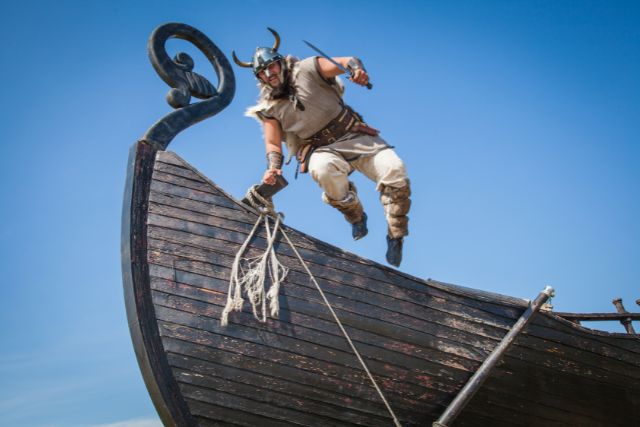In this article, we will delve into the myths and history of Viking helmets, uncovering the truth behind the misconceptions and exploring their design, construction, and purpose.
The Myth of Horned Helmets
In this section, we will explore the widespread myth of horned Viking helmets, tracing their origins and providing evidence to debunk this enduring misconception about Viking warriors.
Origins of the Horned Helmet Myth
The popular image of Vikings wearing horned helmets is deeply ingrained in popular culture. However, this myth can be traced back to the 19th century, during the Romantic era, when artists and writers began to romanticize the Viking past. In particular, the works of artist Richard Wagner, especially his opera “Der Ring des Nibelungen,” played a significant role in promoting this image.

Debunking the Horned Helmet Myth
There is no archaeological evidence to support the idea that Vikings wore horned helmets. In fact, wearing such a helmet would have been highly impractical during battle, as the horns could easily become entangled with an opponent’s weapon. Contemporary Viking art and literary sources also do not depict horned helmets, further disproving the myth.
Historical Background of Viking Helmets
Understanding the historical context of Viking helmets is essential to appreciating their importance. This section provides a brief overview of the Viking Age and discusses Viking warfare and armor, setting the stage for a deeper exploration of Viking helmets.
Viking Age: A Brief Overview
The Viking Age spanned from the late 8th century to the mid-11th century. During this time, Scandinavian warriors, traders, and explorers embarked on expeditions, raids, and settlements across Europe, the British Isles, and North America. The era is known for its skilled seafarers, advanced shipbuilding, and unique artistic styles.
Viking Warfare and Armor
Viking warfare was characterized by its mobility and adaptability. Vikings utilized a range of weapons, including swords, axes, and spears, and they typically fought in a shield-wall formation. Their armor included helmets, which were essential for protecting the head during combat, and chainmail hauberks for additional protection.
Design and Construction of Viking Helmets
This section delves into the materials, key features, and regional variations of Viking helmets, revealing the intricacies of their design and construction and highlighting the craftsmanship that went into creating these iconic artifacts.

Materials Used in Viking Helmet Production
Viking helmets were primarily made from iron, which provided good protection against cutting and stabbing attacks. The helmets were constructed using a combination of forging, riveting, and possibly welding techniques. Some helmets may have also featured additional decorative elements made from bronze or other materials.
Key Features of Viking Helmets
Authentic Viking helmets typically had a conical or rounded shape, designed to deflect blows away from the wearer’s head. A simple brow band encircled the head, with additional metal plates riveted to it, forming the helmet’s main structure. Some helmets also included a nose guard, or “nasal,” which provided additional facial protection.
Helmet Variations and Regional Differences
While there are some common features of Viking helmets, there were likely regional variations in their design and construction. Different areas of Scandinavia may have had their own distinct styles or preferences in terms of helmet shape, decoration, or materials used.
Functionality and Purpose of Viking Helmets
Examining the functionality and purpose of Viking helmets offers insights into their practical use in battle, as well as their potential symbolic and ceremonial significance. This section explores these aspects to better understand the role of helmets in Viking culture.
Protection in Battle
The primary purpose of a Viking helmet was to provide protection to the wearer during combat. The helmet’s design helped to absorb and distribute the force of an incoming blow, reducing the risk of injury. In addition to their protective qualities, the helmets were designed to be lightweight and relatively comfortable, allowing for greater mobility during battle.

Ceremonial and Symbolic Uses
Although Viking helmets were primarily functional in nature, they may have also held symbolic significance. Helmets could be adorned with decorative elements, such as engraved patterns or inlaid metals, which may have represented the wearer’s social status, wealth, or religious beliefs. Additionally, helmets may have been used in ceremonial contexts, such as burials or religious rituals.
Notable Viking Helmet Discoveries
In this section, we will discuss some of the most significant Viking helmet discoveries, such as the Gjermundbu Helmet, and other partial finds. These discoveries provide valuable information about the design and use of helmets during the Viking Age.
The Gjermundbu Helmet
The Gjermundbu Helmet is the only complete Viking helmet discovered to date. Found in a burial mound in Norway in 1943, it dates back to the 10th century. The helmet’s construction features a rounded cap with a brow-band, four main plates, and a nose guard. This find has provided valuable insights into the design and construction of Viking helmets.
Other Significant Finds
While the Gjermundbu Helmet is the only complete example, there have been other discoveries of helmet fragments and partial helmets throughout Scandinavia and Viking settlements. These finds, although incomplete, provide further evidence of the design, construction, and use of Viking helmets during the Viking Age.
Viking Helmets in Popular Culture
Throughout history, Viking helmets have been depicted in various forms of art and media. This section examines artistic portrayals of Viking helmets, highlighting the impact of popular culture on our understanding of Viking history and the persistence of certain myths and misconceptions.

Artistic Depictions
Viking helmets have been the subject of numerous artistic depictions, both historically and in modern times. Although many of these portrayals perpetuate the horned helmet myth, they have contributed to the popular image of the Viking warrior and helped to maintain interest in Viking history and culture.
Modern Misconceptions and Stereotypes
Despite the efforts of historians and archaeologists to debunk the myth of horned Viking helmets, the image persists in popular culture. This misconception is often reinforced by films, television shows, and advertising. While these portrayals can be entertaining, it is important to separate fact from fiction and understand the true history and design of Viking helmets.
Conclusion: Understanding the True Viking Helmet
By examining the myths and history of Viking helmets, we gain a deeper understanding of the Viking Age and the people who lived during that time. While popular culture may perpetuate certain misconceptions, it is essential to recognize the true design, function, and significance of these iconic artifacts in Viking history.











